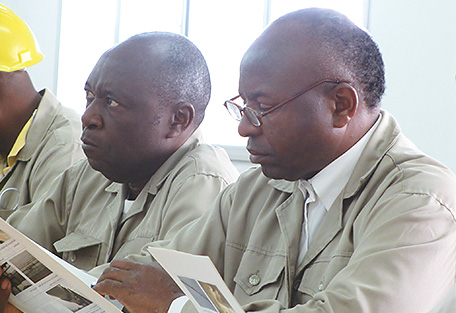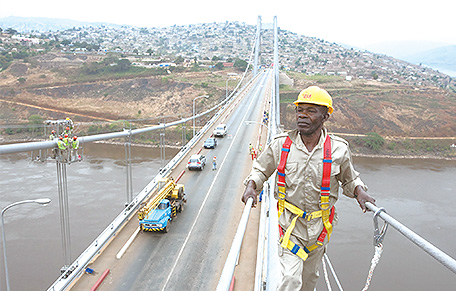Japan's Official Development Assistance White Paper 2013
Stories from the field 01
Protecting the Bridge of Friendship between Japan and the Democratic Republic of the Congo for the Next Generation
– Maintaining Africa’s Largest Suspension Bridge –

Mr. Madiata (right) and Mr. Kalombo (left) listen to an expert’s explanation (Photo: Michiko Miyamoto / JICA)
National Road Number 1 in the central African country of the Democratic Republic of the Congo plays an important role for domestic land transport, connecting the port of Banana on the Atlantic Ocean to the river ports of Boma and Matadi as well as the capital city of Kinshasa. The town that is the stopping point between Banana and Kinshasa, Matadi, is situated just in front of the great waterway known as the Congo River. The Matadi Bridge there provides the only route between the river’s two banks. It is the largest suspension bridge in Africa, and was completed 30 years ago in 1983 thanks to the provision of ODA loans from Japan.
However, upon completion of the bridge, Japan was forced to halt technical cooperation to the Democratic Republic of the Congo due to political turmoil. The only assistance available to the country was the bridge’s maintenance manual which was left by Japan. Nevertheless, the people of the Organization for Equipment of Banana-Kinshasa (OEBK) continued to maintain the bridge for the entire time. Mr. André Madiata is a member of that organization. Involved with the construction of the bridge since 1974, he even participated in a training program in Japan that very year. He commented about the situation at that time:
“When we constructed the bridge, we worked the entire time with the Japanese. And so when we finished and the Japanese left, we very much had the sense of responsibility that we needed to maintain this bridge as a symbol of the friendship between Japan and the Democratic Republic of the Congo.”
To support those efforts, a group was formed by the Japanese involved in the bridge’s construction known as “Matadi Bridge Fellowship.” This group continued to offer technical advice to the members of the OEBK so that they could maintain the bridge. But Mr. Madiata kept hope for the reopening of assistance from Japan.
“If the security situation gets better, the Japanese will cooperate with us again – that promise was our hope, and that hope raised our spirits as we protected the bridge.”
Then, in March of 2012, JICA began the “Project on Capacity Development for Bridge Management (Matadi).” The first thing that this project did was to send Japanese experts to the local area to conduct an investigation of the bridge with the members of OEBK. That investigation revealed that the bridge continued to be well maintained. However, it also revealed an urgent need for a basic inspection of the bridge maintenance, the formulation of a repair plan, and the fostering of younger engineers to fill the positions of the many retiring members of the initial engineering staff. This project sets its goals to construct sustainable systems and foster skills among OEBK members by establishing and updating the bridge’s maintenance plan, and compiling the long-term maintenance work in a manual.
For training in Japan, a program was set up teaching the knowledge and skills needed to maintain the special structures of suspension bridges. Mr. Joseph Kalombo, an OEBK member employed in the construction of the bridge 30 years ago, also participated in that training program.
“In Japan, I learned about the composition of the Honshu-Shikoku Bridge. Observing the bridge really helped me to understand the progress that has been made in Japanese technology. I was particularly surprised to learn about the dehumidification technology used to protect the support cables from moisture.”
Mr. Madiata, a mere worker 30 years ago when the bridge was constructed, is now the Chief of the Maintenance Bureau in charge of the bridge’s maintenance. He is currently working to maintain the bridge together with the younger generations of OEBK members. Young engineers had a hard time during the period of political instability, when they were forced to do work other than bridge maintenance. But since the restart of training by Japan, the situation has started to change.
“Thanks to the training program the Japanese are running, the young people here have started to feel passionate about their jobs. I am so glad that they have developed this new mindset towards their work. The engineers who train in Japan in particular come back with a respect for the deep spirituality, skills, and high-principled character of the Japanese. I am delighted to see the solidarity that emerge among the people who experience the training program.”
The Matadi Bridge, constructed and protected through cooperation between the people of the Democratic Republic of the Congo and Japan, is now a symbol of friendship between the two countries. Asked about his own feelings as he works now with JICA to foster the young people who will take care of this bridge into the future, Mr. Madiata commented:
“I am proud to have been involved in the construction project for this bridge. It is an extremely important asset for the future of the Democratic Republic of the Congo. I feel obligated to continue my work to preserve this bridge for as long as I can.”

OEBK workers maintain Matadi Bridge (Photo: Shinichi Kuno / JICA)
